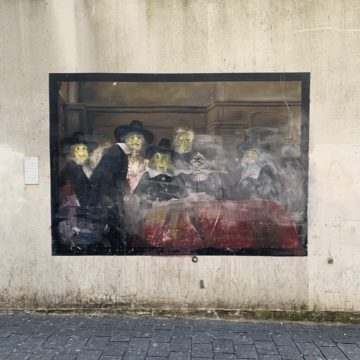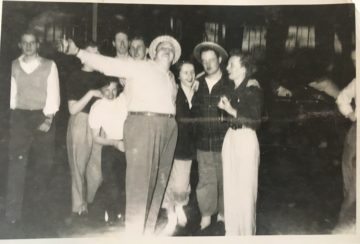by Tim Sommers

The “Crito” by Plato opens with Socrates in prison (circa 399 B.C.E.) awaiting execution, having been unjustly convicted of corrupting the youth of Athens and teaching false gods. When his friend Crito assures him that he can get him out, no problem, that “some people only need to be given a little silver”, Socrates has a surprising response. Suppose Athens were to say to me, he says, “Socrates, did we not agree on this, we and you, to honor the decisions the city makes?” Because the city has basically given birth to me by marrying my father and my mother so they could conceive me. And Athens made me who I am, educating me in the arts and gymnastics and so much more. And I could have left any time. But I stayed. How can I now, having been duly, even if not justly, convicted, leave and put myself above the law?
This may be the earliest extant example of a social contract argument.
Flash forward to 1651. Thomas Hobbes was the first modern philosopher to offer a social contract justification for the state. In “Leviathan” which John Rawls called, “Surely, the greatest work of political philosophy ever written in English,” Hobbes argued that the “state of nature” is “a war of all against all”, and that, in that state, there are “No arts; no letters; no society; and which is worst of all, continual fear, and danger of violent death: and the life of man, solitary, poor, nasty, brutish and short.” (Voltaire is alleged to have quipped, that it was not life in a state of nature, but Hobbes himself, that was “solitary, poor, nasty, brutish and short” (which is demonstrably false since Hobbes was over six feet tall)).
In any case, Hobbes argued that life in the state of nature is so bad that we ought to be willing to agree to almost any sovereign power, in fact, that we need the terror inspired by a Leviathan of absolute power to enforce the law. Hence, absolute monarchy. (And yet, perhaps, there was some small, sly subversion in suggesting that it was not the divine right of kings, but the consent of the governed that the power of the monarch must rest on.) Read more »



 Anticipating war in Europe, 2022.
Anticipating war in Europe, 2022. Over the last few weeks, I’ve been spending more time in the office than I have since the start of COVID. I work for a technology start-up, and our New York office used to look and feel just as shows like Silicon Valley portrayed such offices: cool furniture, fancy coffee machines, lots of free snacks, gaming systems and board games piled up in a dedicated room, and lots of young people who gave the office a fun, high energy, even if noisy, vibe. But this visit, while the snacks and coffee machines are still there, the office has a rather ghost town-like feel. There’s been no mandate to return to the office, so for the most part, people haven’t. Every day I saw my colleague Andy who lives in a Manhattan apartment that’s too crowded with family and a dog. He escapes to the office for some peace of quiet. Then there was the receptionist and the facilities manager, who had no choice but to be there. But that was it for regulars. The odd person would float in for a bit, have a meeting, then leave. Is this the future of office life?
Over the last few weeks, I’ve been spending more time in the office than I have since the start of COVID. I work for a technology start-up, and our New York office used to look and feel just as shows like Silicon Valley portrayed such offices: cool furniture, fancy coffee machines, lots of free snacks, gaming systems and board games piled up in a dedicated room, and lots of young people who gave the office a fun, high energy, even if noisy, vibe. But this visit, while the snacks and coffee machines are still there, the office has a rather ghost town-like feel. There’s been no mandate to return to the office, so for the most part, people haven’t. Every day I saw my colleague Andy who lives in a Manhattan apartment that’s too crowded with family and a dog. He escapes to the office for some peace of quiet. Then there was the receptionist and the facilities manager, who had no choice but to be there. But that was it for regulars. The odd person would float in for a bit, have a meeting, then leave. Is this the future of office life?
 We arrived in Berkeley and found it to be a pleasant place to live. I always have a partiality for small university towns that are culturally and politically alive. And yet Berkeley is not far from a thriving major city (San Francisco—“the unfettered city/resounds with hedonistic glee”, as Vikram Seth describes it in his verse-novel The Golden Gate) on the one hand, and from wide-open spaces on the other. Nature in Berkeley itself is quite beautiful, nestled as it is on a leafy hillside and facing an ocean and its bay, with gorgeous sunsets over the Golden Gate Bridge (on days when it is not shrouded by the mysterious fog—which appears almost as a character in San Francisco noir, like in the crime novels of Dashiell Hammett). Once driving in the dense fog in a winding street in the Berkeley hills I missed a turn and lost my way; I fondly remembered that famous scene in Fellini’s semi-autobiographical film Amarcord, where one winter-day in Rimini, his childhood town, the fog shrouds everything, the piazza disappears, and the grandpa loses his way home.
We arrived in Berkeley and found it to be a pleasant place to live. I always have a partiality for small university towns that are culturally and politically alive. And yet Berkeley is not far from a thriving major city (San Francisco—“the unfettered city/resounds with hedonistic glee”, as Vikram Seth describes it in his verse-novel The Golden Gate) on the one hand, and from wide-open spaces on the other. Nature in Berkeley itself is quite beautiful, nestled as it is on a leafy hillside and facing an ocean and its bay, with gorgeous sunsets over the Golden Gate Bridge (on days when it is not shrouded by the mysterious fog—which appears almost as a character in San Francisco noir, like in the crime novels of Dashiell Hammett). Once driving in the dense fog in a winding street in the Berkeley hills I missed a turn and lost my way; I fondly remembered that famous scene in Fellini’s semi-autobiographical film Amarcord, where one winter-day in Rimini, his childhood town, the fog shrouds everything, the piazza disappears, and the grandpa loses his way home.



 The President and the Provost have both been urging a whitewashing (if I can use this term) of the College’s history by such measures as removing Huxley’s name and bust from one of Imperial’s most prominent buildings. As I explained earlier, they attempted to accomplish this using a deeply flawed process. A History Group lacking in any higher level expertise in Huxley’s own areas of biology and palaeontology was set up, with the College archivist restricted to a consultative role, as was the Imperial faculty member best qualified to comment on historical matters. Two outside historians were consulted, but their areas of expertise did not really include Huxley.1 Adrian Desmond, Huxley’s biographer, was consulted but as I documented in my earlier article, his unambiguous vindication of Huxley was completely ignored. In October (revised version November), the
The President and the Provost have both been urging a whitewashing (if I can use this term) of the College’s history by such measures as removing Huxley’s name and bust from one of Imperial’s most prominent buildings. As I explained earlier, they attempted to accomplish this using a deeply flawed process. A History Group lacking in any higher level expertise in Huxley’s own areas of biology and palaeontology was set up, with the College archivist restricted to a consultative role, as was the Imperial faculty member best qualified to comment on historical matters. Two outside historians were consulted, but their areas of expertise did not really include Huxley.1 Adrian Desmond, Huxley’s biographer, was consulted but as I documented in my earlier article, his unambiguous vindication of Huxley was completely ignored. In October (revised version November), the  I am a modern-day scrapbooker. Which is to say that, like scrapbookers and notebook keepers across the ages, I am incessantly recording: things I have read, things I want to read, ideas I have come across or had, ways I want to be or to look, memorabilia from places I have been or want to go, inspiring or thought-provoking words, song lyrics, images, film clips, you name it. Like those who went before me, I record things in physical notebooks, but – and this is the new thing – my canvas is far larger than this original form. Digital photo albums, the iPhone ‘notes’ pad, emails to self,
I am a modern-day scrapbooker. Which is to say that, like scrapbookers and notebook keepers across the ages, I am incessantly recording: things I have read, things I want to read, ideas I have come across or had, ways I want to be or to look, memorabilia from places I have been or want to go, inspiring or thought-provoking words, song lyrics, images, film clips, you name it. Like those who went before me, I record things in physical notebooks, but – and this is the new thing – my canvas is far larger than this original form. Digital photo albums, the iPhone ‘notes’ pad, emails to self, 
 I used to sit in class with songs in my head, loud enough to feel their beat in my fingertips. I used to blare Adele instead of listening to my teacher. I would sing voicelessly with Hozier while my classmates read a paragraph out loud. Passenger, P!nk, The Lumineers, Steven Sondheim. Billie Eilish, too, though not openly as it’s not cool to like anything that’s cool.
I used to sit in class with songs in my head, loud enough to feel their beat in my fingertips. I used to blare Adele instead of listening to my teacher. I would sing voicelessly with Hozier while my classmates read a paragraph out loud. Passenger, P!nk, The Lumineers, Steven Sondheim. Billie Eilish, too, though not openly as it’s not cool to like anything that’s cool. Daniel Everett’s 2008 book Don’t Sleep: There are Snakes tells two stories of loss. First, it tells how the young missionary linguist, who had been trained to analyse languages at the Summer Institute (now
Daniel Everett’s 2008 book Don’t Sleep: There are Snakes tells two stories of loss. First, it tells how the young missionary linguist, who had been trained to analyse languages at the Summer Institute (now 
 Lots of things don’t exist. Bigfoot, a planet between Uranus and Neptune, yummy gravel, plays written by Immanuel Kant, the pile of hiking shoes stacked on your head — so many things, all of them not existing. Maybe there are more things that don’t exist than we have names for. After all, there are more real objects than we have names for. No one has named every individual squid, nor every rock on Mars, nor every dream you’ve ever had. The list of existing things consists mostly of nameless objects, it seems.
Lots of things don’t exist. Bigfoot, a planet between Uranus and Neptune, yummy gravel, plays written by Immanuel Kant, the pile of hiking shoes stacked on your head — so many things, all of them not existing. Maybe there are more things that don’t exist than we have names for. After all, there are more real objects than we have names for. No one has named every individual squid, nor every rock on Mars, nor every dream you’ve ever had. The list of existing things consists mostly of nameless objects, it seems.
